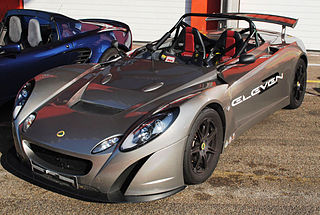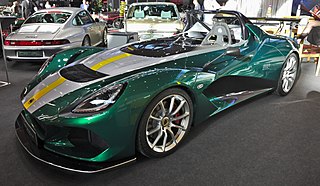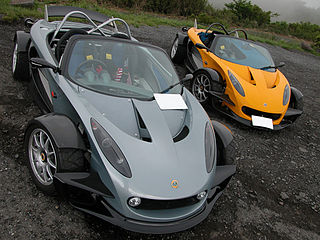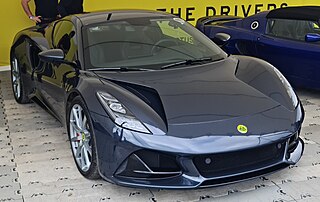 W
WThe Lotus 2-Eleven is a car produced by British car manufacturer Lotus. It is based on the Lotus Exige S, and thus has the same Toyota 2ZZ-GE with VVTL-i, Eaton M62 Roots-type supercharger and intercooled inline-four engine. Weighing 670 kg (1,477 lb), with 252 bhp at 8,000 rpm and 242 N⋅m (178 lb⋅ft) at 7,000 rpm of torque, the 2-Eleven can sprint from 0-60 mph (97 km/h) in 3.8 seconds and has a top speed of 150 mph (241 km/h). Intended as a track day car, it costs £39,995 though for an additional £1,100 Lotus will make the car fully road legal.
 W
WThe Lotus 3-Eleven is a sports car produced by British car manufacturer Lotus Cars. The car is available as a racing version as well as a normal road legal version.
 W
WThe Lotus Elite name has been used for two production vehicles and one concept vehicle developed and manufactured by British automobile manufacturer Lotus Cars. The first generation Elite Type 14 was produced from 1957 to 1963 and the second generation model from 1974 to 1982. The Elite name was also applied to a concept vehicle unveiled in 2010.
 W
WLotus Elan is the name of two separate ranges of automobiles produced by Lotus Cars. The first series of cars was produced between 1962 and 1975 as a rear-wheel drive vehicle. The second series was produced between 1989 and 1995 as a front-wheel drive vehicle.
 W
WThe Lotus Europa name is used on two distinct mid-engine GT cars built by British automobile manufacturer Lotus Cars. The original Europa and its variants comprise the Lotus Types 46, 47, 54, 65 and 74, and were produced between 1966 and 1975.
 W
WThe Lotus Europa name is used on two distinct mid-engine GT cars built by British automobile manufacturer Lotus Cars. The original Europa and its variants comprise the Lotus Types 46, 47, 54, 65 and 74, and were produced between 1966 and 1975.
 W
WLotus Cars Limited is a British automotive company headquartered in Norfolk, England. It manufactures sports cars and racing cars noted for their light weight and fine handling characteristics.
 W
WLotus Cars Limited is a British automotive company headquartered in Norfolk, England. It manufactures sports cars and racing cars noted for their light weight and fine handling characteristics.
 W
WLotus Cars Limited is a British automotive company headquartered in Norfolk, England. It manufactures sports cars and racing cars noted for their light weight and fine handling characteristics.
 W
WThe Lotus Type 108 is an Olympic individual pursuit bicycle. Its frame is an advanced aerofoil cross-section using a carbon composite monocoque.
 W
WLotus Cars Limited is a British automotive company headquartered in Norfolk, England. It manufactures sports cars and racing cars noted for their light weight and fine handling characteristics.
 W
WLotus 119 was a box car built by Lotus Cars to compete at the Soapbox Challenge that took place at the 2002 Goodwood Festival of Speed. It is believed to be the fastest box car built, capable of 200 mph on a 45 degree slope. Several types were built, with the 119c at present being the fastest.
 W
WThe Lotus 340R is a limited edition sports car manufactured by Lotus Cars in 2000 at their Hethel factory.
 W
WThe Lotus APX is a concept car created by the British automobile marque, Lotus. It was first introduced at the 2006 Geneva Motor Show, and was also displayed as the Proton MSX. It is the first complete vehicle built on the new Versatile Vehicle Architecture (VVA). This vehicle is also a first for Lotus, as it is the first crossover SUV they have ever built. It was to have entered production as the Youngman Lotus T5, but was cancelled.
 W
WThe Lotus Éclat is a sports car built from 1975 to 1982 by British automobile manufacturer Lotus Cars. It was based on the Elite but had a fastback body style which offered more practicality with storage in the boot (trunk), albeit with less headroom above the rear seats. The car was initially to be called the "Elite Coupe". The lower half of the fibreglass bodywork was actually identical to that of the Elite.
 W
WLotus Elan is the name of two separate ranges of automobiles produced by Lotus Cars. The first series of cars was produced between 1962 and 1975 as a rear-wheel drive vehicle. The second series was produced between 1989 and 1995 as a front-wheel drive vehicle.
 W
WThe Lotus Elise is a two-seat, rear-wheel drive, mid-engined roadster conceived in early 1994 and released in September 1996 by the British manufacturer Lotus Cars. The Elise has a fibreglass body shell atop its bonded extruded aluminium chassis that provides a rigid platform for the suspension, while keeping weight and production costs to a minimum. It is capable of speeds up to 240 km/h (150 mph). The Elise was named after Elisa Artioli, the granddaughter of Romano Artioli who was chairman of Lotus and Bugatti at the time of the car's launch.
 W
WThe Lotus Elite name has been used for two production vehicles and one concept vehicle developed and manufactured by British automobile manufacturer Lotus Cars. The first generation Elite Type 14 was produced from 1957 to 1963 and the second generation model from 1974 to 1982. The Elite name was also applied to a concept vehicle unveiled in 2010.
 W
WThe Lotus Emira is a sports car manufactured by British automobile manufacturer Lotus Cars. It is intended to be the firm's final vehicle powered by an internal combustion engine.
 W
WThe Lotus Esprit is a British sports car that was built by Lotus Cars at their Hethel factory in England between 1976 and 2004. It was among the first of designer Giorgetto Giugiaro's polygonal "folded paper" designs.
 W
WThe Lotus Ethos is a fully plug-in hybrid concept car that was unveiled at the 2010 Paris Motor Show as the "Lotus CityCar". The vehicle was developed by Lotus Engineering, a separate division from Lotus Cars. The CityCar has a lithium battery pack with an all-electric range of 60 kilometres (37 mi), and after the battery is depleted the 1.2-liter petrol engine kicks in to help with charging, allowing the car to run more than 500 kilometres (310 mi). The concept car is designed for flex-fuel operation on ethanol, or methanol as well as regular petrol.
 W
WThe Lotus Etna is a one-off concept car designed by Giorgetto Giugiaro, who also designed the Lotus Esprit. It premiered at the 1984 British International Motor Show. It is powered by a 4.0-litre V8 of Lotus design, code-named the Type 909.
 W
WThe Lotus Europa name is used on two distinct mid-engine GT cars built by British automobile manufacturer Lotus Cars. The original Europa and its variants comprise the Lotus Types 46, 47, 54, 65 and 74, and were produced between 1966 and 1975.
 W
WThe Lotus Europa S is a two-seat mid-engine sports car, designed to be a more toned down and comfortable variant of the driver focused Lotus Elise and its derivative, the Exige. The Europa S is a modern version of the Europa line of the 1960s and 1970s.
 W
WThe Lotus Evija is a limited production electric sports car to be manufactured by British automobile manufacturer Lotus Cars. Unveiled in July 2019, it is the first electric vehicle to be introduced and manufactured by the company. Codenamed "Type 130", its production will be limited to 130 units.
 W
WThe Lotus Evora is a sports car produced by British car manufacturer Lotus. The car, which was developed under the project name Project Eagle, was launched on 22 July 2008 at the British International Motor Show. The Evora S was launched in 2010 with a supercharged 3.5-litre V6. A facelifted and more powerful Evora 400 model was unveiled at the 2015 Geneva Motor Show, followed by another more powerful variant, the Evora GT430, which was unveiled in 2017.
 W
WThe Lotus Excel is a sports car designed and built by British automobile manufacturer Lotus Cars from 1982 to 1992. It is based on the design of the earlier Lotus Eclat, which itself was based on the earlier Lotus Type 75 Elite.
 W
WThe Lotus Exige is a British two-door, two-seat sports car made by Lotus Cars since 2000. Originally a more-hardcore coupé version of the Lotus Elise roadster, since the Series 3 the Exige has been the larger-engined model of the family - using a V6 engine in place of the Elise's straight 4 with convertible versions of both available.
 W
WLotus Cars Limited is a British automotive company headquartered in Norfolk, England. It manufactures sports cars and racing cars noted for their light weight and fine handling characteristics.
 W
WThe Lotus Mark VI is the first production car by Lotus Cars. It was introduced by Colin Chapman in 1952 after previously building multiple trials and road racing cars. The heart of the Mark VI is a space frame chassis. Rather than a complete car, it was available to the general public as kit, wherein the customer could install any preferred engine and gearbox, making it eligible for a wider number of formulae.
 W
WThe Lotus Carlton is a Vauxhall Carlton/Opel Omega A saloon upgraded by Lotus in order to be able to reach speeds up to 285 km/h (177 mph) with acceleration to equal contemporary sports cars. Like all Lotus vehicles, it was given a type designation—Type 104 in this case. The exterior changes were minimal with the addition of a rear spoiler, cooling vents on the bonnet, Lotus badges on the front wings and bootlid, a bodykit and considerably wider wheel arches distinguishing it from a standard Carlton/Omega. The car was only sold in one colour, a shade of green called Imperial Green.
 W
WThe Lotus Seven is a small, simple, lightweight two-seater open-top sports car produced by the British manufacturer Lotus Cars between 1957 and 1972.
 W
WThe Lotus Éclat is a sports car built from 1975 to 1982 by British automobile manufacturer Lotus Cars. It was based on the Elite but had a fastback body style which offered more practicality with storage in the boot (trunk), albeit with less headroom above the rear seats. The car was initially to be called the "Elite Coupe". The lower half of the fibreglass bodywork was actually identical to that of the Elite.
 W
WThe Lotus Seven is a small, simple, lightweight two-seater open-top sports car produced by the British manufacturer Lotus Cars between 1957 and 1972.
 W
WWet Nellie is a custom-built submarine, created for the 1977 James Bond film The Spy Who Loved Me in the shape of a Lotus Esprit S1 sports car. The Esprit was chosen to give James Bond a glamorous car to drive. "Wet Nellie" is named in reference to Little Nellie, an autogyro featured in the James Bond film You Only Live Twice, which was itself named after actress and comedian Nellie Wallace.
 W
WThe Lotus Elise is a two-seat, rear-wheel drive, mid-engined roadster conceived in early 1994 and released in September 1996 by the British manufacturer Lotus Cars. The Elise has a fibreglass body shell atop its bonded extruded aluminium chassis that provides a rigid platform for the suspension, while keeping weight and production costs to a minimum. It is capable of speeds up to 240 km/h (150 mph). The Elise was named after Elisa Artioli, the granddaughter of Romano Artioli who was chairman of Lotus and Bugatti at the time of the car's launch.